| | Home
ICELAND ... but first a
digression....
We got stranded in the vicinity of Bergen's airport for a day, due to mechanical problems on what we began to suspect might have been IcelandAir's only airplane.... Lots of time for thinking, reading, napping and otherwise spending down time, and for me, it was a good morning for thinking again about language, which I’d been thinking about a lot on this trip – being generally in a situation of relying entirely on the kindness of strangers. If that doesn't interest you, just go ahead and scroll down to where we actually get to Iceland....
The language situation is one of the main reasons I’ve not wanted to go abroad. It’s not so much a fear of being lost in an incomprehensible environment; it’s embarrassment at being in someone else’s land and expecting them to understand my language, when we Americans have almost made it a credo to make no comparable effort to learn the languages of others so we can at least extend them the same degree of understanding when they visit us. I could, of course, have spent some time before we left learning rudimentary communication in the languages of the countries we visited – but frankly, the magnitude of that rudimentary effort staggered me. Four languages for four adjacent countries, and none of them even say “hello” or “thank you” in the same way. My aging memory apparatus just shrugged and said forget it.
I’ve been through two language-learning programs: two years of Latin in high school and two years of German in college. I did middling in both of them; I could understand the rules whereby they strung words together, and I could read them so long as I had a good glossary in the back of the book, but I couldn’t remember the words – or more important, for the language speaker, I couldn’t remember the sounds the words I couldn’t remember were supposed to approximate. And that’s really the key. Written language, like a music score, is just a set of abstract symbols meant to approximate as accurately as possible the sounds people have developed for their own internal communication, and there are almost an infinite number of ways we can make sounds that can lead to effective communication if the hearer of the sounds can translate them. There are some people who are excellent at that; then there are people like me whose minds have a hard enough time processing sounds in my own language.
One thing we know about language-learning is that we are born with more language-learning ability than we have left by the time we are 15 years old or so. Children who grow up in a bilingual situation will “naturally” pick up both languages – and will have a better capacity for learning additional languages later in life. But taking “foreign languages” after we are 12 years old or so is no longer a “natural” act for most of us. Something in the hardwiring of the brain has hardened around the set of sounds we are used to, and new sets of sounds do not easily find a home in our hardwiring.
This being the case, it seems obvious that, if we really wanted our children to grow up with a well-developed language capability, we would start them on “foreign languages” as soon as we started them in school, or maybe even before. This is, in fact, what they do in Europe, and in the countries we visited. Most of the Europeans we encountered speak at least three languages including Passable English, and it just makes me feel like a damned inferior human being. Even up in Samiland (northern Norway and Finland), one of the world's last “hunter-gatherer” outposts, the Sami kids are mostly trilingual by the time they are 15 – speaking their native Sami, either Norwegian or Finnish, and English. Close to the Norwegian/Finnish border, most of them also know enough of the language across the border to get by. Considering that all of these languages are trying to use the common alphabet of the Romance languages, those languages without Romance roots – well, all of them – have to doctor up the basic 26 letters with all kinds of umlauts, accents, slashmarks and other markings to cover the gamut of their sounds, which creates texts and signs that look like someone shook a brush full of paint at them…. The Finns and the Sami both have a propensity for doubled vowels – especially “a” and “i” – and they just love “k,” to the extent that they frequently put two “k”s back to back, and it’s not that unusual to see four or five “k”s in a word that seems to go on for a week and a half…. The Finns also never got around to inventing prepositions, so their nouns have up to 15 different case endings: “Helsinki” would have a different ending depending on whether one is going “to Helsinki” or “from Helsinki” or “in Helsinki.” The Norwegians and Swedes, on the other hand, have a predilection for “j”s slipped in front of a vowel, but because their languages have a lot of the same phonetic and linguistic roots as English, we were able to at least decipher the essence of signs enough to not be too lost most of the time. (Although we never did figure out what some of the cautionary and presumably mandatory roadsigns were trying to tell us.)
I keep thinking I’ll start trying to learn some conversational Spanish, just because it seems like a decent thing to do in the American Southwest today, which, despite the paper trail of the Treaty of Guadelupe Hidalgo in 1848, continues to be a cultural ecotone, a more or less open edge-zone between the Anglo-American and Latin-American cultures. But despite being sort of retired, or maybe on account of it, I’m having a hard time fitting in most of the things I said I was going to do after retiring, and this one would be hard enough for my aging brain so it keeps getting put off….
But an Innocent Abroad, depending on the kindness of strangers much more cosmopolitan and global than he, does begin to wonder: when is America going to join the rest of the world, to the extent of beginning to let our kids learn to communicate with the global society at a time when their language acquisition skills are at their peak? For most of the 20th century, we were so important in the global economic and political environment that we could expect the rest of the world to have to learn to communicate with us. But it is probably time to note that things are changing. In a couple three decades, we’ve gone from being the world’s largest creditor nation to being its largest debtor nation; growing quantities of America’s assets are owned by nations to whom we have absolutely staggering debts, and China is now buying around a billion dollars a day of T-bills, just to keep pumping money into our economy so we will continue buying what they produce – surely one of the strangest and most fragile economic arrangements in history. We once led the world in production of just about everything; now we lead it only in the consumption of just about everything, and the great once-American corporations that created the global economy as we know it today are demonstrating that they have no particular allegiance to America; they go wherever their costs are least. We are, in sum, slipping, and English may not be the “lingua argenta” of the world forever….
AND ANOTHER BRIEF DIGRESSION WHILE WAITING FOR THE PLANE TO BE FIXED....
We had dinner last night, and lunch again this noon, with a fellow who grew up in Iceland, went to Norway in the 1970s, and got work on “The Platforms” – the Norwegian drill rigs out in the North Sea. He is traveling with his three sons to Iceland, to visit his and his wife’s parents for the next few weeks. The boys are basically growing up in Norway, but they have Iceland passports ("because Iceland has no military service"), and he and his wife (both Iceland natives) speak only Icelandic at home; they want the boys to think of themselves as Icelanders just living in Norway….
He will have a good leisurely stay in Iceland (assuming we all ever get there); the work schedule on The Platforms is two weeks on (with 12-hour shifts) and four weeks off. This is probably good sociology as well as good economics, and reflects the fact that, while all the usual suspects – Exxon/Mobil, Standard, BP, etc. – are leasing the gas and oil and running the actual work, the whole operation is run by Statoil, a government organization. The Platform jobs pay well, but it is a stressful and isolated work environment and they were having trouble keeping employees – it was possible to rack up a small fortune under the old four on, four off schedule, and leave. But two on, four off means a good living rather than a small fortune, and a lot of family time for people like Arn.
He has been working on The Platforms pretty much since the beginning, back in the early 1970s, and feels really lucky to have gotten in early. Today, he says, to get a job on The Platforms “you have to know somebody,” and then, before you can go to work, you have to take a three-week safety course. There was no safety course at all when he went to work there; the companies probably didn’t know how dangerous it might be…. But he speaks highly of the companies and their work policies. He said the basic safety rule is, take care of yourself first; the hell with the platform. This confirmed something we’d read a couple days ago at the Coastal Museum (see an earlier post): one very expensive blowout on a platform had cost the company – Phillips, I think it was – a lot of money, but no lives, and a company spokesman had said, “We can replace a platform, but we can’t replace a father.”
I asked Arn how Norwegians felt about paying eight or ten dollars a gallon for gasoline – mostly taxes – when their country is raking in massive sums through Statoil as the world’s second-largest oil exporter behind Saudi Arabia. It has been my understanding that the government uses the proceeds from both the Norwegian taxes and the global oil revenues for public transportation, hydropower development, and other efforts to prepare for the time when their oil windfall is exhausted.
But Arn has a less positive sense of that. “Have you seen our roads?” he asked when I raised the question. I described the roads here a couple posts ago: national highways that have almost no shoulders and are mostly two lane, even through the cities, and state highways that have no center line and range in width from relatively comfortable two-car width to very uncomfortable one-car width, with occasional wide spots for one car to wait for another car to come by. Yes, we’d seen the roads. He said that the government “is like Scrooge McDuck in the comics” – arm motions of raking it in – “but they don’t like to spend anything.”
I asked him about the public transportation, which he doesn’t find all that impressive. But I will say that it strikes me as really impressive – and obviously a system that requires a lot of subsidy. On all those narrow little roads, way out in the countryside, there is still a public bus turnout and shelter every mile or so. (A blessing in that the bus turnouts are more places where one car can move over to let another one pass, but there’s no way to describe the paralyzing terror of coming around a mountain curve and seeing the big yellow front of a bus right there….) I suspect it would be easy to take a system like that for granted if you had never known anything else, but for a Coloradan, from where we can’t even get bus service on a major east-west highway, it seems kind of miraculous. And all those electric trains, and hydropower plants – someone is spending a lot of everyone’s money on a post-petroleum future. And it probably isn’t Scrooge McDuck, who would find all that disgustingly socialistic.
But on to Iceland....
ICELAND

 Fate
finally conspired to let us get to
Iceland – or at any
rate, ceased conspiring against it. We got in around midnight Sunday,
and
Icelandair was again kind enough to put us up overnight since it was
too late
to carry out any other plans. It staggers the imagination a little to
think
what an episode like this must cost an airline – having to house
and feed a
couple hundred people for a day, help them all make other arrangements,
et
cetera.
Fate
finally conspired to let us get to
Iceland – or at any
rate, ceased conspiring against it. We got in around midnight Sunday,
and
Icelandair was again kind enough to put us up overnight since it was
too late
to carry out any other plans. It staggers the imagination a little to
think
what an episode like this must cost an airline – having to house
and feed a
couple hundred people for a day, help them all make other arrangements,
et
cetera.
But now we’re in Iceland – a strange and wonder-full place that might be epitomized in the picture above: a pastoral farmscape, richly green, with increasingly rugged and ominous hills rising above it to dark-rock Mordor-like mountains, and a glacier creeping out of the mountains toward the lovely scene below.... It's not unlikely that there might be an active volcanic fault under the glacier somewhere.... That's Iceland.
Iceland fills the bill for the mythical place that the Greek and Roman navigators called “Ultima Thule,” the land at the cold and frozen end of the earth (although Greenland fills it better). After our first day here, we could believe the “cold and frozen” part; I haven’t been so cold and frozen in July since the year it snowed on the Fourth of July during the Gothic-to-Crested Butte marathon.
Our tour of Iceland began on a part of the island too new for life to have really taken hold, a place so unsuited for animal life that there was nothing to do with it but put a city there, and that’s what the Icelanders eventually did, after settling into the nooks and crannies of more inhabitable land in farming and fishing villages. Reykjavik, Iceland’s only real city – somewhere around 150,000-175,000 people, half the country’s population – sits on a peninsula of lava where plant life has barely had time to start. In on-again-off-again rain, sleet and sun, we drove through miles of black rock which has no life on it other than a thick green moss capping the rocks and, of course, tourists tracking through it on Iceland’s rough approximations of highways.
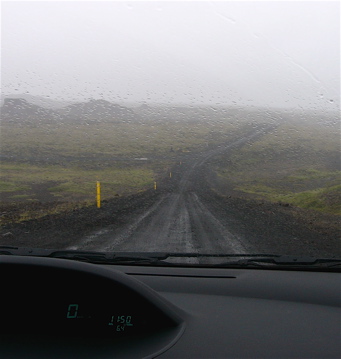
Engineers too inhabit this primal landscape of extreme southwestern Iceland, hard at work on the geothermal powerplants that have been built there. Iceland could advertise itself as “the land of renewable energy”; while the rest of the world is struggling to get to 10 or 20 percent renewable energy, Iceland is already at 80 percent – all geothermal and hydropower. This will probably never be a solar energy site, given their long dark winters, but we can personally attest to the presence of a lot of wind that wants employment.
Under a gray sky with strong steady sea-winds blowing, we headed inland to a place that is probably the heart and soul of Iceland – a place called Thingvellir. That’s not quite right: the Icelandic language basically adheres to “Old Norse,” whose alphabet has a letter for the “th” sound that looks like a “P” whose loop has slid halfway down its stem, and I can’t find it in this program's symbols. So we’ll go with the “th.”
Thingvellir is, first of all, a natural wonder – maybe a natural disaster in the making. Iceland is basically a tectonic belch right on top of the Mid-Atlantic Rift, the deep trench running down the Atlantic Ocean (and on around through the world’s other oceans) from which all the rock plates that make up the crust of the earth are issuing. Magma boils up from the core of the earth, is cooled to stone by too much water to vaporize, and more magma boiling up pushes those stone masses away from the great rift, big growing stone plates that push into each other, grind past each other, ride over the top of each other, in long slow frictive action that episodically results in the sudden “adjustments” we call earthquakes, volcanoes, tsunamis, et cetera.
And Iceland, sitting right on top of the Mid-Atlantic Rift, is cracking up; part of the island is currently moving eastward with the plate that eventually surfaces as Europe, and the rest of it is moving westward with the plate that emerges as North America. And this movement seems fast for geological change – a steady two centimeters a year, according to information at the visitors’ center at Thingvellir. This has resulted in a widening “rift valley”: as the two parts of Iceland slowly spread apart, a valley maybe a mile wide is sinking down into the crack, and pulling away from the land to either side of the crack, resulting in some incredibly spectacular geology – Here are pictures from Thingvellir....
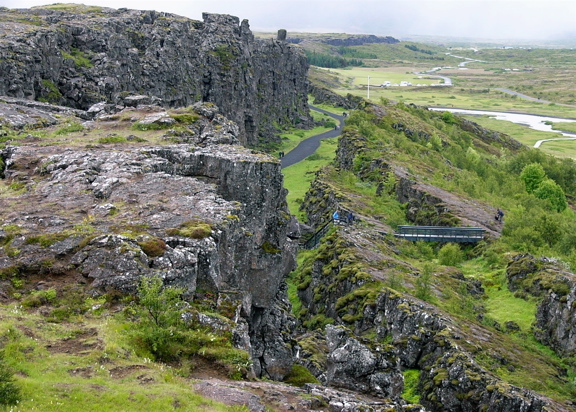
To the right above is the rift valley; the crack in the center is where the North American plate (left of the crack) is pulling away from the rest of Iceland and heading west. The next picture is looking eastward over the rift valley (and the river that runs through it) toward a similar crack where the European plate is heading east....
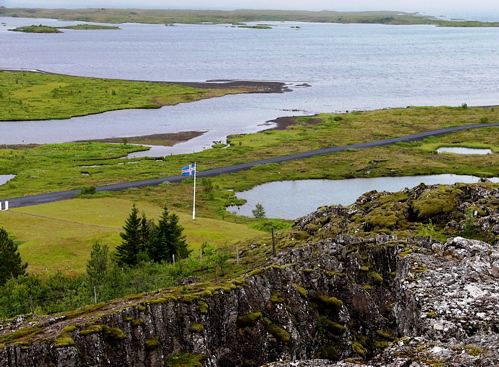
The smaller river running in from the left (above) comes off the North American plate, and drops down into the crack between that plate and the rift valley, eventually running out of the crack into the valley; below is the stream in the crack.

This strange place became an important part of the history of the Icelandic people, who had no real idea what was going on geologically underfoot. Iceland has only had humans on it for a little over eleven hundred years, people who were suffering the consequences of the population growth that followed the melting of the Big Ice in Europe (the population explosion that is still going on globally, although the European nations seem to finally be getting it under control). Northern European hunter-gatherers forced into farming and herding by the population explosion eventually ran out of good farmland and began to move out into surrounding lands, at first diffidently but eventually quite aggressively in the Viking era. In the late 800s, some Norsemen seeking the Faeroe Islands got blown off course and luckily found Iceland (next stop Greenland, a long ways farther); they got word back to friends and relatives, and the standard northern European culture of fishing or herding (the guys) and farming (the gals) commenced.
They settled in clan-group bands with “Big Man” leaders – the guys with the management skills to keep a band of people on task and more or less happy with their lot. There were the usual conflicts between groups over boundaries, on land and sea, and the Big Men met together to sort those out, and as the population grew, they realized they needed a better organization – but like the Europeans who moved onto the farther continent 800 years later, they realized they didn’t want to do it the European way, with a king or pope and a bunch of strong men jostling about in a “might makes right” political culture. So they agreed to create a kind of a parliament, what they called the “Thing,” which would meet once a year in the summer for a couple weeks, to, in essence, make order among themselves. They would develop an evolving set of laws as needed, and a court that would try to articulate the common will on conflicts based on interpretation of the laws.
And where did they choose to hold the Thing? In this nice flat valley that was centrally located – a valley that was sinking several millimeters a year, one of the most unstable pieces of land on earth, the rift valley where Iceland was being torn in two. Was this symbolic of human efforts to make order among themselves? Well, actually, the Thing worked well, most of the time, for around 900 years – and was only abandoned after Iceland had put together a more formal parliamentary system based 60 or so kilometers west in Reykjavik. Until that time – with occasional lapses back into internal Viking nonsense and episodes of conquest from European nations – not just the Big Men but most of the people gathered at Thingvellier ("Thing Place") for what became a combined political, legal and social event. It began with the “speaking of the law” (before writing) from a place high on the rocks where North America was heading west, and went from there to a cross between a parliament, a court and a county fair. To a great extent, the Thing was one significant root of the democratic impulse in European civilization.
The last big “Thing” at Thingvellir was on June 17, 1944, when half of the nation turned out – maybe 75,000 people at that time – for a reading of a “Declaration of Independence” from whichever European nation had made it a protectorate or colony or whatever at that time (Denmark, I think, although by then the U.S. had a World War II air base there that remained until 2004).
And this all happened in a valley that sank something like four meters during the millennium-plus that it was going on, a valley in which tectonic action is a visible and almost a tangible presence.
Icelandic mythology, as written down 800 years or so ago by Snorri Sturlasson, tells of creation beginning with ice from the region of Niflheim and fire from the region of Muspelheim pouring into the Ginnungagap and all life eventually emerging from where they met. Even the fastest tour of the strange and wonderful island of Iceland imprints the impression that this creation is still underway, with all the unresolved and powerful chaos the pouring together of fire and ice suggests.
Iceland's location on top of the Mid-Atlantic Rift has also created a lot of very active volcanic “hot spots” on and around the island – several of which volcanoes are covered with up to a kilometer of glacial ice! The island itself is basically all volcanic “tephra” of one kind or another – “tephra” being the geologist’s word for all the different kinds of stuff (hot ash, rocks of all sizes and weights and temperatures, molten lava, et cetera) spewed up by volcanoes – and it is still spewing, as recently as 2002. The study of Iceland’s geology is what finally put the seal of almost universal acceptance on the theory of plate tectonics as the official explanation for the way earth’s basic structure works.
The result of all this geological activity is a great variety of landscapes that range from pastoral tranquility at one extreme to utter jumbled chaos at the other – aesthetically, from a soft green beauty to hard and terrible scenes that, as one geologist put it, we haven’t yet learned enough to describe in terms like “beautiful or ugly.” Here as in Norway, most of the inhabitants live within a few miles of the coast – and there aren’t all that many of them either. Outside of Reykjavik, where more than half of Iceland’s total population of 300,000-plus lives, most of the settlements are too small to even be called “towns” in the conventional American sense. The Icelanders did not have land routes connecting all parts of the island until the completion of the “Ring Road” around the island in 1974, and most of the interior of the island is still basically wilderness with “tracks” negotiable only by serious four-wheel-drive vehicles; some of it is so primally barren and alien to life that the astronauts used it for learning to walk on the moon.
One consequence of the jumbled and hilly terrain, coupled with a lot of North Atlantic weather, is a lot of waterfalls. A lot of waterfalls. We started out taking pictures of all of them, but eventually became a little more selective.... The first one we saw, the Gullfoss ('foss' = waterfall) on the Hvita River in west central Iceland, is also probably the largest....

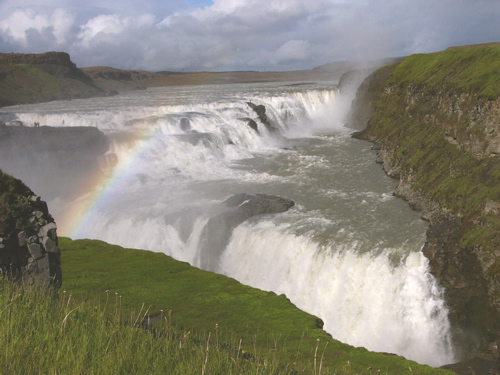
These are some others "fosses" that we saw along the way....
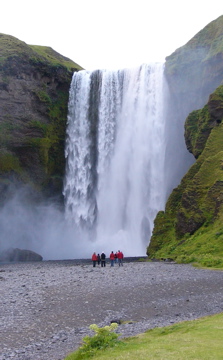
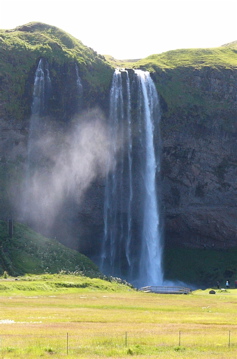
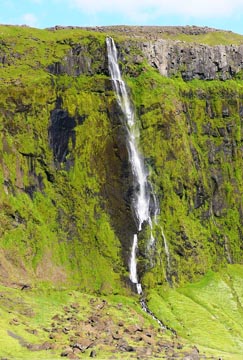

Iceland’s south coast has a very humid climate with lots of summer rain – we were lucky to have three mostly clear days after a really cold rainy one the first day here. It is a great climate for growing hay – although less great probably for drying and baling it – and the fields, like our Gunnison valley’s fields, are beautiful vivid greens. But that doesn’t stop with the cultivated fields but spreads on up those steep slopes of in mossy/grassy growth, with even the cliffs often green with “mossfalls” (see waterfall pictures above), all of it in “wet greens,” unlike our western “dry greens,” that make me think of an old Kris Kristopherson line: “too green to be real.”
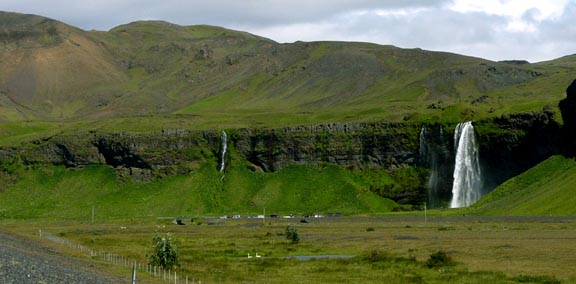
Many of the sheep ranches have their own churches, a tradition dating back to the Christianization of the island in the year 1000....
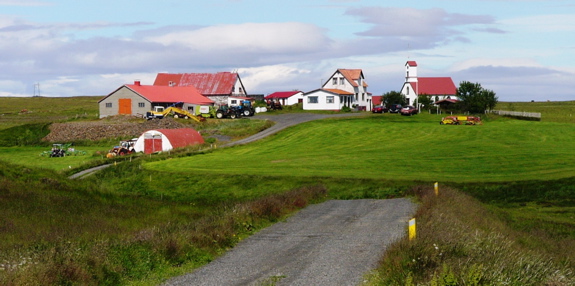

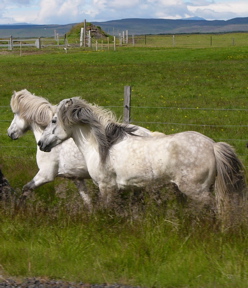
But those lovely pastoral settings also change frequently, in the blink of an eye almost, to the most barren and desolate landscapes imaginable. Flat pebbled peneplains that might be the wind and water’s master plan for the end of the earth, nothing to get in their way as they blow and blast around. Or jumbled volcanic boulders with thick caps of moss on them. Or what appears to be a river course a quarter-mile wide with a braided muddy stream running through it. Then another steep green hill with a sudden steep climb out of a valley over a grassy green ridge between two of those weird volcanic hills and a steep descent into another valley – all this on what we’ve come to accept as the standard Scandinavian first-class highway: two eight to 10 foot lanes with 12-inch shoulders, and a center line if you’re lucky.
Away from the coast – often not very far at all – Iceland has some serious mountain country, much of which is buried under icecaps that send glaciers tumbling down the valleys. Here's an icefall at Vatnajokull, Iceland's biggest glacier....

We spent most of a day poking around the edges of a couple of the bigger glaciers – “jokulls,” in Icelandic. All of Iceland’s glaciers – along with most glaciers around the world – are in retreat today, and could only be called “beautiful” with several miles of aesthetic distance. Up close and impersonal, they are a mess – if you saw in May or June 2008 the remnants of the huge piles of snow in St. Peter’s parking lot in Gunnison, then you have seen what the snout of a retreating glacier looks like. And they leave behind a mess – random piles of gravel and rocks that give the impression of a huge but badly run gravel operation. It is basically a scene of devastation, the consequence of natural excesses almost beyond imagining. Here are some pictures of Myrdalsjokull, from afar to nearer....
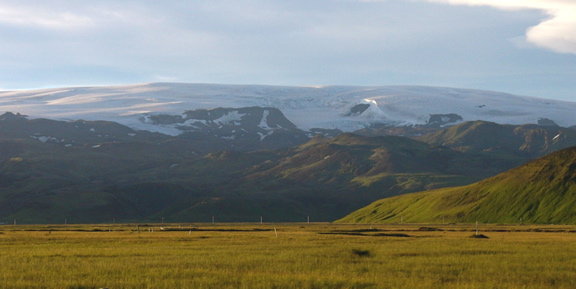

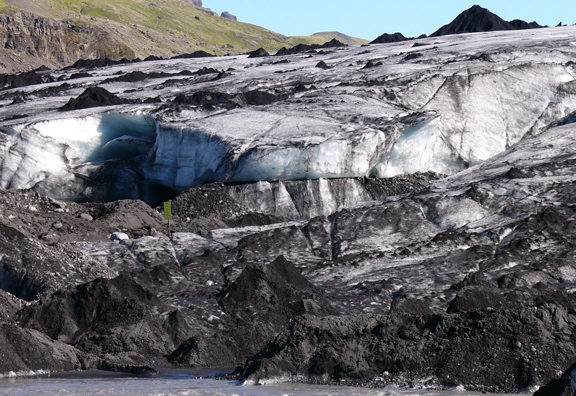
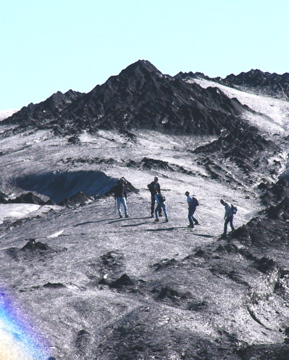
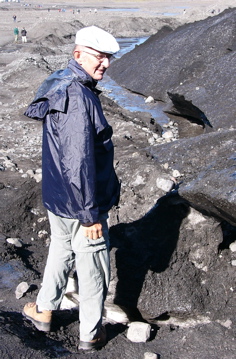
Whole mountains get buried beneath snow that started out as white fluffy stuff, but too much came each year to melt, for many, many years, until it was so deep that the weight of all that once-fluffy white stuff compressed itself into ice from which all the air had been squeezed, ice capable of breaking and grinding rock, depressing the crust of the earth itself – Finland, we read somewhere, is still rising millimeters every year after the departure of the continental ice sheets that existed as recently as 10,000 years ago in northern places.
Iceland’s remaining “jokulls” are remnants from that Ice Age, and are showing today on a “small” scale the massive changes that nature’s extreme sports can visit on the planet. But Iceland adds another twist to extreme nature. Among the mountains buried under all that ice are a number of active volcanoes, and the “hot spots” where more volcanoes are inevitably going to emerge. What happens when a volcano erupts under a kilometer of moving ice? In the most literal sense, all hell breaks loose.
Geologists and other earth scientists got a great chance to observe all hell breaking loose in 1996, with all the advantages afforded by cameras, helicopters, sophisticated measuring devices and other tools for documenting nature at work and play. That year, an earthquake – common as rain in Iceland – opened a new fissure under the island’s largest glacier, Vatnajokull, and magma gushed up under the ice. Within a matter of days it melted a hole all the way to the surface, releasing clouds of hot ash. Lava under the glacier continued the melting and a huge underground body of water built up, and when enough of it had collected, it simply lifted the whole ice mass enough to rush out in a “jokullhlaup” – a glacial flash flood of cataclysmic proportions. The jokullhlaup ran for two days, then, as the eruption slowed, dropped back to the normal “leakage” from under a glacier, which is a river of some substance in times of glacial retreat. But the flood had run the 22 kilometers to the ocean in a flash flood half a kilometer wide, running 50,000 cubic meters per second at its peak, and carrying everything in its path along with it – which was mostly just the Ring Road and its bridges because that area was already so devastated by previous jokullhlaups that there was nothing else in its path…. As a monument to that, two of the big bridge girders, twisted like pretzels, are displayed on a pullout along the Ring Road. Here is a highly inadequate picture of the floodwash left by that jokullhlaup....

Skaftafell National Park, at the base of Vatnajokull (but out of the jokullhlaup paths), has a visitors’ center that tells this whole story, with good videos (in the usual three or four language choices), along with a lot of other fascinating information about this place where “Niflheim’s ice and Muspellheim’s fire” come together. I find it hard to see beauty in this junction of elemental forces – I’ve never been much of a fan of gravel pits and mine sites, and this is earth-moving action that makes any mine site look like Tonka Toy work. But to see it, to stand in the middle of it, is certainly impressive, a little intimidating, somewhat overwhelming. I can look at the greenery sneaking over, clambering up, dripping down over the bare rock of this young island and see real beauty there, as well as a kind of purposefulness: life makes the work liveable by spreading over this elemental chaos and breaking down the rock to soil, combing the violence out of flowing air and water, et cetera. But the fire and ice underlying it all, and episodically overwhelming it all, just seem kind of mindless and devoid of any purpose. It snows, and snows and snows; the wind blows, and blows and blows; the melted rock blows and cools, and blows and cools and blows and cools; but none of it has any sense of interaction. It’s just shit happening, and life calms and moderates it around the edges, but can’t touch the cores of all that undirected and undirectable action.
We stopped at a place where the Vatnajokull kind of meets the ocean, a snout of it dropping bergs and floes of ice into a bay....
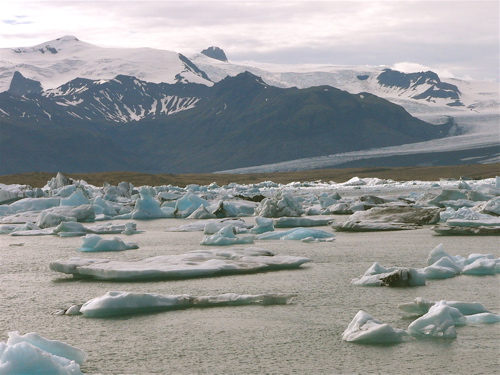
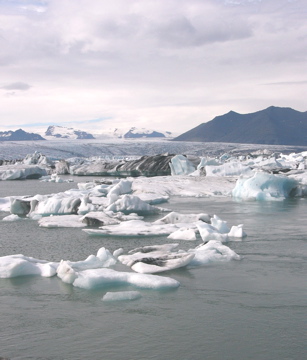
There are vast swaths of Iceland that are owned by the fire and ice – places where life is not going to make significant inroads until the fires under the island are banked, the ice gone (which could be happening). But even in the great stretches dominated by the volcanoes and ice caps, there were pockets of life where the plants had made sufficient inroads even to support large mammals like us and the sheep and cows we travel with. Stong was such a place – Iceland’s first serious archeological site, Stong was a farm “developed” in the 11th century in a beautiful little valley feeding a stream into a flat peneplain of volcanic barrens, over which looms the chronically active volcano Hekla.
Stong sits at the end of a four or five kilometer dirt “track” that is not on the major tour-bus routes, which was nice, but one wonders how the farmer that created the farm, and the family that built the farmhouse whose foundations are now protected under a roof built by the government – how did they ever find this place? It is at once, a reminder of how population pressure was driving humans out into every possibly inhabitable niche of the world, and also of the creativity and vitality of the species that would build around such a slender and fragile thread of life in the shadow of Hekla – which eventually buried the farm, a century or so after its founding. This is Stong's valley with the larger, barren valley beyond....

We wandered on up beyond the excavated ruins of the farm - now enclosed in the red shelter seen above - and found ourselves in a small, steep and incredibly green valley, a magical place – ranked with all the larger, more magnificent places we saw, it ranks very close to the top for me. We came around a corner and saw a slender little waterfall tumbling in about three drops down a wall of volcanic rock, with its attendant “mossfalls.” Then went on a little farther up the valley and found another, bigger one, with shorter falls, bouncing down through a steep grassy meadow. Then a little farther along, around a rock intrusive – and there was an even bigger one, falling over basaltic columns into a lovely round pool, coming out of what appeared to be an inaccessible valley beyond, and how could we doubt that there was a waterfall falling into that valley, from another valley higher fed by another waterfall, and so on, to the waterfall from heaven itself? And that wonderful green valley had come into being in the century or so since Hekla’s last deconstruction and reconstruction of the region in the 1800s. Hekla is basically overdue to blow again anytime – “not if but when” in the language of the Skaftafell National Park visitors’ center. A couple shots from that valley....
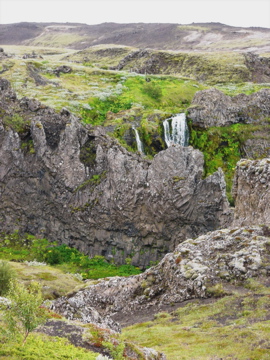

The first thing to say about contemporary Iceland is that it is two pretty distinct cultures. There’s Reykjavik, the city at the far western tip of Iceland, and then there’s the rest of Iceland. We spent most of our time there in “the rest of Iceland,” but had a day in Reykjavik, and the difference is striking.
“The rest of Iceland” is the most thoroughly rural region I have ever seen – where it is even that. Much of Iceland is basically the domain of the volcanoes and glaciers – largely uninhabitable areas of volcanic rock and glacial cobble. The whole island is probably best described as a construction zone where nature is working out whatever the island is going to be with the seat-of-the-pants approach nature uses for such work.
But there are many places where the lichens, basic plants and ultimately birch trees have broken down the volcanic surface of the land, added organic content and basically created rich land with all the agricultural potential that the climate will allow – which isn’t all that much; like our valley, they are limited by a short and cool growing season. Basically they are still doing what they’ve been doing for a thousand years there, and that’s raising sheep, and the feed they need to get their sheep through the long dark winters. The mountain valleys and open parks (there are places that reminded us of South Park) are vividly green with whatever kinds of grasses or plants they are feeding their sheep, and the homes dotted around the landscape all look reasonably prosperous.
But what seems to be missing in Iceland is farm communities – the kind of small towns we see as we drive through our farming regions, every 20-40 miles or so: a place to take things that need to get fixed, to buy groceries and clothes and all the stuff you aren’t growing at home, to go to the doctor. A place with a Walmart and two or three gas stations, a franchise or two feeding off the highway, et cetera. Once you leave the outskirts of Reykjavik, you cannot count on seeing service communities. Sometimes the only gas within a hundred kilometers or more will be from a completely untended pump at the roadside that you need a credit card to operate – and you need to know your PIN. There are few places to get a cup of coffee or a soda, and even fewer to get a beer. All alcoholic beverages are sold through “vin bud” stores – but the one vin bud we visited to pick up a six pack was basically a convenience store with nothing in the way of alcoholic beverages but a single stack of about seven cases of beer. We stayed in one lodging in Skogafoss – actually the dormitory of small public college, run as a hostel/hotel in the summer – where there was no other place in the town (Pop. 26) to eat, get gas or groceries, have a beer or do anything other than go look at the local waterfall (which was impressive). There was, however, a public camping ground within sight of the waterfall.
Before going to Iceland, we both read a great novel about the place and its people – “Independent People,” by Halldor Laxness, who won the Nobel Literature Prize in the 1950s for this and other work. The book was a beautifully written but ultimately sad story of a family of sheep farmers in Iceland, which shone an empathetic but ultimately somewhat merciless light on the hard streak of individualism and independence that supposedly runs through the Icelandic people. I was still reading it as we flew into Iceland, and a stewardess asked me if I was enjoying the book. “Enjoying” isn’t always a good term for a book that is about difficult people going through difficult circumstances, but I said I was certainly appreciating it, and asked her if she had read it; she said it had been a hard book for her because it was mostly her grandmother’s life story. I asked a slightly prickly woman at a folk museum we went to about the authenticity of the book, and she said the book made her angry because she saw so much of herself in it, and didn’t like the mirror Laxness held up.
But it seemed to me that only people who valued self-reliance and individualism above all other values could create and live with such a minimalist culture as Iceland has, beyond it’s only real city. For the most part, rural Icelanders don’t seem to either mind the tourists or go out of their way to encourage them. I had the feeling that we were kind of like weather to them – a phenomenon like rain that helped some and hindered others, but there was no sense complaining about us even though there were more big tour buses clogging up the roads every year…. Maybe the knowledge that sooner or later they and all their works are going to be eradicated by a volcano develops – or at least selects for – a certain stoic quality of character that asks and gives little.
REYKJAVIK....
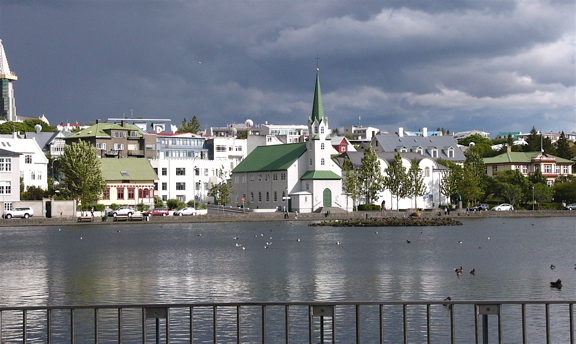
Reykjavik is "another Iceland" completely. No problem getting a beer there, or anything else you want and can afford (although it’s hard to find a cup of coffee before 8:00 in the morning). In its layout, it was like a lot of the other cities we visited in Scandinavia and Finland: a pre-auto city surrounded by an auto-era city. The pre-auto city, as usual, had grown around the “old harbor,” a region of narrow streets and old buildings with open squares that were once market places, but seem to be no longer (unlike Helsinki’s and Bergen’s). During the light months, the core city is always full of people, usually getting it on to some extent or another. Why go to bed if the sun doesn’t? It is not a huge city – 170,000 or so – and a lot of them appear to be young and full of it.
Beyond that core city, however, auto-era Reykjavik seems a little more “American” than European – a little more suburban. The public transit system doesn’t seem as thoroughly developed as Finland’s or Norway’s, only extending a couple hundred kilometers beyond Reykjavik. And the choice of vehicle types is certainly more American: instead of the small economic cars favored in most of Europe, Icelanders go for big four-wheel-drive vehicles. The fact that most of the interior of the island is still highly unimproved roads (rental-car contracts forbid going there) gives at least the rural inhabitants an excuse for big consumptive vehicles, but they are also favorites in and around Reykjavik too, for “sex-toy” reasons that are probably very American.
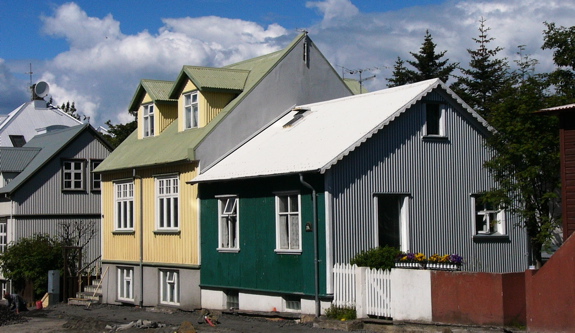
So – wherever you go, there you are. That’s a good place to start winding down this rambling narrative. Here's Lief Erickson in Reykjavik looking westward, and we were ready to look westward too by the time we got there....

Putting these pages together a few months after returning home, already a lot of things are starting to disappear like a dream after waking – wandering around in the devastation that is a glacier in retreat, looking at the consequences of a volcano blowing up under a glacier, flying over the southern end of Greenland (half an hour of nothing below but the smooth blank surface of a subcontinent buried under snow and ice), the cold wind out of the north on the sound on the west side of Porsanger Peninsula in Samiland far up in the Arctic, standing in the valley where North America is pushing away from Europe at two centimeters a year.... And juxtaposed against all that natural wonder, curiosity at advanced cultures that have lousy narrow highways – but run public buses all the way along those highways a couple times a day; an oil-exporting nation that charges nine bucks a gallon, most of it taxes to prepare for the time when the oil runs out; electric trains that actually leave and arrive on time; nations that put tax money toward national health care and other public services rather than a monstrous military machine; a culture trying to go in a few decades from a hunter-gatherer heritage to post-industrial “intelligent tourism” (not necessarily an oxymoron). And cities that have matured into the idea that cities can be enjoyable places to live – wide sidewalks and narrow streets rather than the other way around, with outdoor tables everywhere for people watching; interesting-looking buildings rather than “functional-looking” buildings; free museums encouraging people to learn who they’ve been.... I’m like the guy in the “Far Side” cartoon who wants to be excused from class because “My brain is full.”